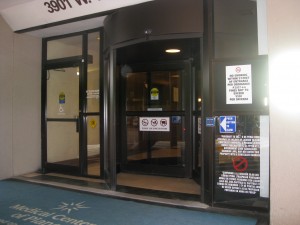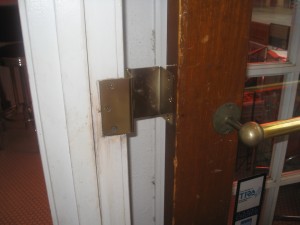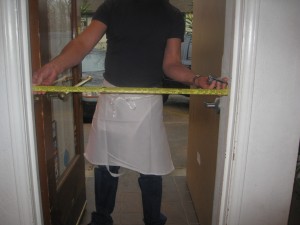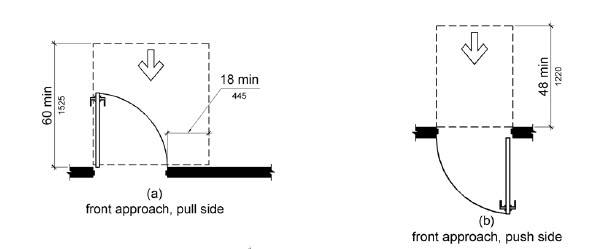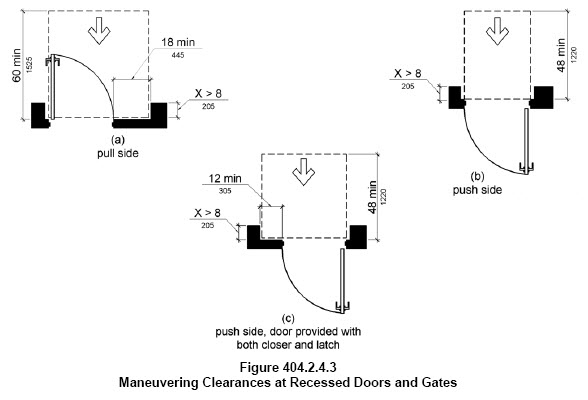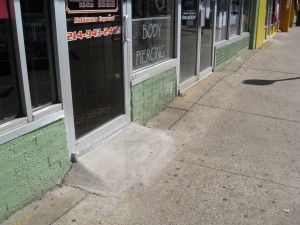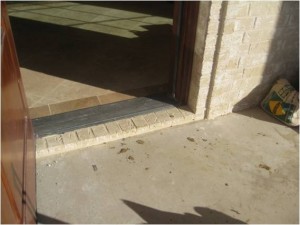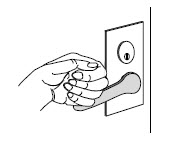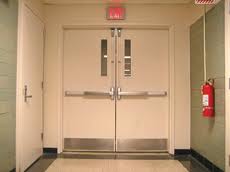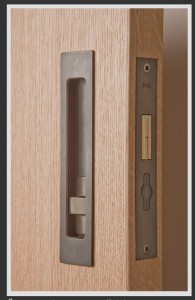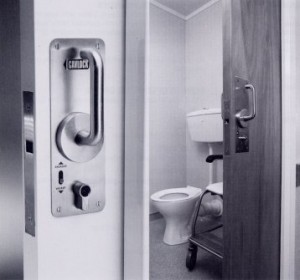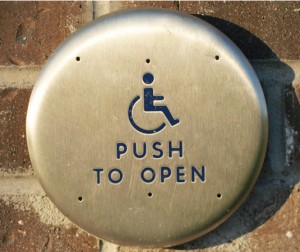Are your doors accessible?
Posted on - Thursday, May 5th, 2011Doors are one of the main elements that will make a space accessible or not. If the interior space is accessible, but the door is too narrow, or a person can’t open the door and use the hardware, then the space cannot be really accessible.
In the 2010 ADA Accessible Standards, doorway requirements are found on Section 404 Doors, Doorways and Gates (Page 217 of The ADA Companion Guide). Some scoping requirements are also found in Section 206.5 Doors, Doorways and Gates. In summary, here are the technical requirements for doors:
- Revolving doors should not be part of the accessible route. That means that you need a swing door alongside it if you want to use a revolving door.
2. Double leaf doors should have one active door at 32” (unless a power assisted door with stand-by power is used, then the entire width of both leaves are counted together)
3. Clear widths are 32”. Hardware can decrease the width by 4” if mounted between 34” and 80” high (except closers that can be mounted 78” a.f.f.). If you have an existing door that is 34″ wide (and then the width of the door makes the clear opening less than 32″, then add fully overlay hinges and it will make the clear opening exactly 34″.
4. Maneuvering clearances follow figure 404.2.4
5. Recessed doors are allowed but only 8” max. of recess
6. Ground surface at door maneuvering clearances should be no steeper than 2%
7. Thresholds at doorways shall not exceed 1/2″
8. Door hardware hall have a shape that is easy to grasp with one hand and does not require tight grasping, tight pinching, or twisting of the wrist to operate.
9. Door hardware should be mounted no higher than 48” a.f.f. except in secured areas like pool gates where you can mount up to 54” a.f.f.
10. If a door has a door closer, then the sweep period of the closer shall be adjusted so that from an open position of 90 degrees the door will take at least 5 seconds (changed from 3 seconds) to move to a point 12 degrees from the latch, measured to the leading edge of the door.
11. Interior and sliding or folding doors must have a maximum force of 5 lbs.
12. From 0”-10” above the ground should have a smooth surface
13. Vision lights should be mounted 43” a.f.f. max to the bottom
14. Automatic and power-assisted doors shall be on a stand by power for it to be used instead of the maneuvering requirements listed above
Operating door hardware
Sliding doors are a great way to save space and still have privacy. In an accessible design, the hardware becomes the most problematic. There are some hardware that will make the width narrower than 32” wide, and sometimes the pocket type sliding doors have the type of hardware that requires the use of the hands by twisting, pulling or pinching the hardware in order to use it. See this video on how most hardware works
Below are some hardware that are not good for accessibility. The recessed handle could work if the gap is wider than a fist. In other words, person who does not have good use of their fingers (like people with rheumatoid arthritis, or cerebral palsy) would only have the use of a closed fist to operate this door. So the gap will have to be wide enough to allow them to use it.
The hardware on this door will allow for a person to use their fist inside the loop, but to design the opening, the designer will have to take into account the door handle. A 32” wide door will not work since the door handle will make the opening narrower.
The hardware shown on this photo can be lifted with a closed fist and it is narrow enough where the door opening will not narrow as much once the pocket door is recessed.
Automatic doors
Power assisted doors are very useful if the maneuvering clearances at doors and the door hardware is such that does not allow independent use by disabled people. If there are existing doors that do not have the proper width, proper maneuvering clearances or proper hardware, then a power assisted door will be useful since their automatic type mechanism will open the door for the person who can’t open it on their own. But in the 2010 Standards, the only way to not require the maneuvering clearances shown on Table 404.2.4.1 is to use a power assisted door with stand by power. Then the landing requirements, push and pull side clearances and even widths at double leaf doors will not be required.
 Abadi
Abadi 

